Open Door Policy
That corner office with a view… That corner office with a view and a solid-oak door that is always closed… That corner office with a view, a solid-oak door that is always closed and what appears to be 7,500 square feet of windows... It’s funny that many CEOs (and employees for that matter) who claim that they want to increase communication in their office are from that corner office. They are closed off from the world and – more importantly - their employees.
An Approachable Air
For large chunks of time throughout the day, you need your door closed so you can get work done without constant interruptions, but many CEOs make it a habit. The communication capacity of your organization starts at the top and it starts with how approachable you are, or if you are approachable at all. No one likes the silent treatment – in fact, it’s the most common cause for conflict in romantic relationships - your employees aren’t going to like it either, especially when they look up to their leader.

The Need for Visible Leaders
Leaders that can steer an entire organization towards increased profitability are hard to find. These leaders need to be visible and open to display their charismatic qualities. Your employees need a figure they see regularly and who is easily approachable.
Dr. Marlene S. Neill, assistant professor in Baylor’s College of Arts & Science, studied the trends within Fortune’s “100 Best Companies to Work For.” Dr. Neill explained that these trends, "Indicate a move to a more strategic role for internal communication and more dialogue with employees rather than one-way communication." Basically going from a command approach to an open door, dialogue approach.
Dialogue and Feedback
A study in the International Journal of Productivity and Quality Management depicted how trust is vital to keep your best employees. D. Keith Denton of the Missouri State University explained, "Companies with high-trust levels give employees unvarnished [great choice of word] information about company's performance and explain the rationale behind management decisions. They are also unafraid of sharing bad news and admitting mistakes. Lack of good communication leads to distrust, dissatisfaction, cynicism and turnover." Guess what is a great method for accomplishing this? You guessed it, an open door policy.
In fact, communication between employees and top level management was one of the top 5 most important indicators of employee job satisfaction according to the Society for Human Resource Management. Denton went on to say that research indicates that old-fashioned face-to-face communication is the most effective. He added, “One-on-one conversations and small group meetings take time, but are well worth the investment. It is the only place where true dialogue can and does occur.”
Putting an Open Door Policy into Practice

It would be naive to think that you could constantly have your door open, talk to every visitor that happens by and still get the same amount of business-driving work done. Instead, you could have an established period of time where your door is always open – say 1:00pm to 4:00pm. If your door is closed, you can let your employees know that you have an “open email policy” where they can always reach you, or they can pick up the phone and call you for pressing issues. In fact our CEO, Shawn Burcham, has a window of time each Friday that is reserved for any employee that wants to schedule themselves on his calendar. Since he continually travels, he feels this is important so there is always time to talk. Simple and effective!
These methods will help you create a culture that understands they can always reach you and get the dialogue and feedback they need. This will build trust and loyalty in the office and in the long run decrease employee turnover.
Wrap-Up
There is no specific method or strategy for an open door policy. As a CEO, you need to determine that fine line (it might be hard at first) between improving communication and actually getting work done yourself. But if you accomplish this, you will foster business communication with every face-to-face conversation you have from the comforts of that corner office!
Make sure to read our entire Business Communication series to help increase your bottom-line!

